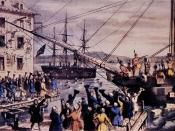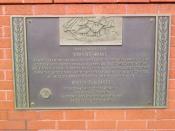On December 16, 1773, resistance leader Samuel Adams signaled to start the Boston Tea Party, with the words "this meeting can do no more to save this country." With that, they set out for the famous rebellion. But what really signaled the Boston Tea Party? Taxes. In attempt to increase England's revenue there were the Sugar Act of 1764 then the Stamp Act of 1765. Before the actual Revolutionary War could begin, there had to be a revolution "in the minds and hearts of the people," as John Adams stated. A document establishing the assent of George III "by commission" on March 22, 1765 was an important factor. It was to be known as the Stamp Act. It was soon obvious this act had a dynamite influence politically. The Stamp Act was the first direct tax imposed by Britain on its American colonies supported by George Grenville. With the purpose to help cover the cost of maintaining troops in the colonies, Parliament levied a tax on legal and commercial documents as well as printed material including newspapers all of which had to carry a special stamp.
This took effect in November 1765. Americans not electing members of the Parliament opposed the act not only because of their inability to pay the new tax, but also because it violated the principle "No taxation without representation." Resistance to the act took the form of petitions to the king and Parliament, a boycott of British goods, the refusal of lawyers or printers to use stamps or stamped paper, and violence sparked by the Sons Of Liberty. The constitutional principles and protest tactics established during the Stamp Act laid the foundation for the coming of the American Revolution. The debate in Parliament proved to be bitter with a well-argued testimony by Benjamin Franklin...



Recieving Negative Rating
Attention people! If you rate my essays poor please inform me why so I can improve in the future.
What makes this essay bad? I know it's brief but the facts are their and my teacher thought it was interesting. Please explain your reason for the negative rating. Thank You.
2 out of 4 people found this comment useful.